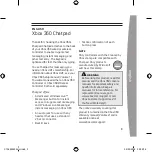
11
MEASUREMENTS
m
ounTing
The
sensor
Although the Unisense microsensors are made of glass, the tip
is flexible and can adjust slightly around physical obstacles .
However, large obstacles like stones or coarse lateral movements
of the sensor when the tip is in contact with a solid substrate may
cause the tip to break .
Due to the small size of the microsensor tip and to the steepness
of gradients in many environments, even a displacement of the
sensor tip of few microns may change its environment .
Therefore we recommend that measurements are performed
in a stabilized set-up fixed on a sturdy table free of moving or
vibrating devices . We recommend the Unisense lab stand LS18
and the Unisense micromanipulator MM-33 (MM33-2 double) for
laboratory use . For in situ use we recommend our in situ stand
(IS19) and a micromanipulator .
e
lecTrical
noise
As well as the physical size, the electrical current generated by the
high-impedance temperature microsensor is very small .
Although the Unisense temperature microsensor is quite resistant
to electrical noise from the environment, electrical fields may
interfere with the sensor signal . Minimize this by switching off
unnecessary electrical/mechanical equipment and avoid touching
sensor or wires during operation .
On suspicion of sensor damage, repeat calibration and consult
“Troubleshooting” .
WARNING
Always introduce
and retract the
temperature
microsensor
axially using a
micromanipulator
and a stable stand
when measuring in
solid or semisolid
substrate like
sediment, tissue,
biofilms, microbial
mats etc.
Summary of Contents for TP-MR
Page 1: ...1 TEMPERATURE SENSOR USER MANUAL ...
Page 2: ...Temperature sensor user manual Copyright 2012 Unisense A S Version October 2012 ...
Page 3: ...TEMPERATURE SENSOR USER MANUAL UNISENSE A S ...
Page 4: ......
Page 15: ......
Page 16: ...UNISENSE DENMARK www unisense com info unisense com ...


































